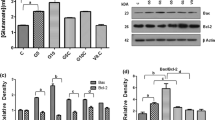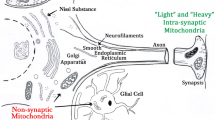Abstract
Excitotoxicity due to excessive glutamatergic neurotransmission is a well-studied phenomenon that has been related to the mechanisms of neuronal death occurring in some disorders of the CNS. We have previously shown that the intrahippocampal perfusion by microdialysis of 4-aminopyridine (4-AP) in rats stimulates endogenous glutamate release from nerve endings and this results in excitotoxic effects such as immediate seizures and delayed neuronal death, due to the overactivation of N-methyl-d-aspartate (NMDA) receptors. To study whether mitochondrial energy dysfunction and oxidative stress could be involved in this 4-AP-induced excitotoxicity, we evaluated in awake rats the protective effect of several energy substrates and antioxidant compounds, using microdialysis, electroencephalographic (EEG) recording and histological analysis. The 4-AP-induced behavioral and EEG seizures, which progressed to status epilepticus in about 30 min, were prevented by the NMDA receptor antagonist MK-801, whereas acetoacetate, dl- and l-β-hydroxybutyrate did not protect against seizures but increased the latency to the onset of status epilepticus; pyruvate, α-ketoglutarate and glutathione ethyl ester did not show any protective effect. 4-AP also produced nearly complete loss of pyramidal neurons in CA1 and CA3 regions of the ipsilateral hippocampus 24 h after the experiment. MK-801 totally prevented this neuronal death and the energy substrates tested protected by about 50 %, whereas the antioxidants showed only a weak protection. We conclude that ketone bodies possess weak anticonvulsant effects and that energy metabolism impairment plays a more important role than oxidative stress in the delayed hippocampal neurodegeneration resulting from the excitotoxic action of 4-AP mediated by endogenous glutamate.




Similar content being viewed by others
Abbreviations
- 4-AP:
-
4-Aminopyridine
- ACAC:
-
Acetoacetate
- dl-βHB:
-
dl-β-Hydroxybutyrate
- EEG:
-
Electroencephalogram
- GEE:
-
Glutathione ethyl ester
- GSH:
-
Reduced glutathione
- KB:
-
Ketone bodies
- NMDA:
-
N-Methyl-d-aspartate
- Pyr:
-
Pyruvate
- αKG:
-
α-Ketoglutarate
References
Peña F, Tapia R (1999) Relationships among seizures, extracellular amino acid changes, and neurodegeneration induced by 4-aminopyridine in rat hippocampus: a microdialysis and electroencephalographic study. J Neurochem 72:2006–2014
Peña F, Tapia R (2000) Seizures and neurodegeneration induced by 4-aminopyridine in rat hippocampus in vivo: role of glutamate- and GABA-mediated neurotransmission and of ion channels. Neuroscience 101:547–561
Vera G, Tapia R (2012) Activation of group III metabotropic glutamate receptors by endogenous glutamate protects against glutamate-mediated excitotoxicity in the hippocampus in vivo. J Neurosci Res 90:1055–1066
Jekabsons MB, Nicholls DG (2004) In situ respiration and bioenergetic status of mitochondria in primary cerebellar granule neuronal cultures exposed continuously to glutamate. J Biol Chem 279:32989–33000
Nicholls DG (2008) Oxidative stress and energy crises in neuronal dysfunction. Ann N Y Acad Sci 1147:53–60
Wang Y, Qin ZH (2010) Molecular and cellular mechanisms of excitotoxic neuronal death. Apoptosis 15:1382–1402
Mehta A, Prabhakar M, Kumar P, Deshmukh R, Sharma PL (2013) Excitotoxicity: bridge to various triggers in neurodegenerative disorders. Eur J Pharmacol 698:6–18
Maus M, Marin P, Israel M, Glowinski J, Prémont J (1999) Pyruvate and lactate protect striatal neurons against N-methyl-D-aspartate-induced neurotoxicity. Eur J Neurosci 11:3215–3224
Izumi Y, Zorumski CF (2010) Neuroprotective effects of pyruvate following NMDA-mediated excitotoxic insults in hippocampal slices. Neurosci Lett 478:131–135
Shetty PK, Sadgrove MP, Galeffi F, Turner DA (2012) Pyruvate incubation enhances glycogen stores and sustains neuronal function during subsequent glucose deprivation. Neurobiol Dis 45:177–187
Pan R, Rong Z, She Y, Cao Y, Chang LW, Lee WH (2012) Sodium pyruvate reduces hypoxic-ischemic injury to neonatal rat brain. Pediatr Res 72:479–489
Massieu L, Haces ML, Montiel T, Hernández-Fonseca K (2003) Acetoacetate protects hippocampal neurons against glutamate-mediated neuronal damage during glycolysis inhibition. Neuroscience 120:365–378
Maalouf M, Sullivan PG, Davis L, Kim DY, Rho JM (2007) Ketones inhibit mitochondrial production of reactive oxygen species production following glutamate excitotoxicity by increasing NADH oxidation. Neuroscience 145:256–264
Kim DY, Vallejo J, Rho JM (2010) Ketones prevent synaptic dysfunction induced by mitochondrial respiratory complex inhibitors. J Neurochem 114:130–141
Samoilova M, Weisspapir M, Abdelmalik P, Velumian AA, Carlen PL (2010) Chronic in vitro ketosis is neuroprotective but not anti-convulsant. J Neurochem 113:826–835
McNally MA, Hartman AL (2012) Ketone bodies in epilepsy. J Neurochem 121:28–35
Paxinos G, Watson C (1982) The rat brain in stereotaxic coordinates. Academic Press, Sydney
Ramírez-Munguía N, Vera G, Tapia R (2003) Epilepsy, neurodegeneration and extracellular glutamate in the hippocampus of awake and anesthetized rats treated with okadaic acid. Neurochem Res 28:1517–1524
Massieu L, Morales-Villagrán A, Tapia R (1995) Accumulation of extracellular glutamate by inhibition of its uptake is not sufficient for inducing neuronal damage: an in vivo microdialysis study. J Neurochem 64(5):2262–2271
Ayala GX, Tapia R (2003) Expression of heat shock protein 70 induced by 4-aminopyridine through glutamate-mediated excitotoxic stress in rat hippocampus in vivo. Neuropharmacology 45:649–660
Ayala GX, Tapia R (2005) Late N-methyl-D-aspartate receptor blockade rescues hippocampal neurons from excitotoxic stress and death after 4-aminopyridine-induced epilepsy. Eur J Neurosci 22:3067–3076
Khatri N, Man HY (2013) Synaptic activity and bioenergy homeostasis: implications in brain trauma and neurodegenerative diseases. Front Neurol 4:199. doi:10.3389/fneur.2013.00199
Satpute R, Lomash V, Kaushal M, Bhattacharya R (2013) Neuroprotective effects of alpha-ketoglutarate and ethyl pyruvate against motor dysfunction and oxidative changes caused by repeated 1-methyl-4-phenyl-1,2,3,6 tetrahydropyridine exposure in mice. Hum Exp Toxicol 32:747–758
Mejía-Toiber J, Montiel T, Massieu L (2006) D-beta-hydroxybutyrate prevents glutamate-mediated lipoperoxidation and neuronal damage elicited during glycolysis inhibition in vivo. Neurochem Res 31:1399–1408
Lim S, Chesser AS, Grima JC, Rappold PM, Blum D, Przedborski S, Tieu K (2011) D-β-hydroxybutyrate is protective in mouse models of Huntington’s disease. PLoS One 6:e24620
Shimazu T, Hirschey MD, Newman J, He W, Shirakawa K, Le Moan N, Grueter CA, Lim H, Saunders LR, Stevens RD, Newgard CB, Farese RV Jr, de Cabo R, Ulrich S, Akassoglou K, Verdin E (2013) Suppression of oxidative stress by β-hydroxybutyrate, an endogenous histone deacetylase inhibitor. Science 339:211–214
Desagher S, Glowinski J, Prémont J (1997) Pyruvate protects neurons against hydrogen peroxide-induced toxicity. J Neurosci 17:9060–9067
Wang X, Perez E, Liu R, Yan LJ, Mallet RT, Yang SH (2007) Pyruvate protects mitochondria from oxidative stress in human neuroblastoma SK-N-SH cells. Brain Res 1132:1–9
Noh HS, Hah YS, Nilufar R, Han J, Bong JH, Kang SS, Cho GJ, Choi WS (2006) Acetoacetate protects neuronal cells from oxidative glutamate toxicity. J Neurosci Res 83:702–709
Cheng B, Lu H, Bai B, Chen J (2013) d-β-Hydroxybutyrate inhibited the apoptosis of PC12 cells induced by H2O2 via inhibiting oxidative stress. Neurochem Int 62:620–625
Fernandez-Gomez FJ, Pastor MD, Garcia-Martinez EM, Melero-Fernandez de Mera R, Gou-Fabregas M, Gomez-Lazaro M, Calvo S, Soler RM, Galindo MF, Jordán J (2006) Pyruvate protects cerebellar granular cells from 6-hydroxydopamine-induced cytotoxicity by activating the Akt signaling pathway and increasing glutathione peroxidase expression. Neurobiol Dis 24:296–307
Miao Y, Qiu Y, Lin Y, Miao Z, Zhang J, Lu X (2011) Protection by pyruvate against glutamate neurotoxicity is mediated by astrocytes through a glutathione-dependent mechanism. Mol Biol Rep 38:3235–3242
Cheng B, Yang X, An L, Gao B, Liu X, Liu S (2009) Ketogenic diet protects dopaminergic neurons against 6-OHDA neurotoxicity via up-regulating glutathione in a rat model of Parkinson’s disease. Brain Res 1286:25–31
Haces ML, Hernández-Fonseca K, Medina-Campos ON, Montiel T, Pedraza-Chaverri J, Massieu L (2008) Antioxidant capacity contributes to protection of ketone bodies against oxidative damage induced during hypoglycemic conditions. Exp Neurol 211:85–96
Zeevalk GD, Manzino L, Sonsalla PK, Bernard LP (2007) Characterization of intracellular elevation of glutathione (GSH) with glutathione monoethyl ester and GSH in brain and neuronal cultures: relevance to Parkinson’s disease. Exp Neurol 203:512–520
Dringen R (2000) Metabolism and functions of glutathione in brain. Prog Neurobiol 62:649–671
Bough KJ, Rho JM (2007) Anticonvulsant mechanisms of the ketogenic diet. Epilepsia 48:43–58
Bough KJ, Eagles DA (1999) A ketogenic diet increases the resistance to pentylenetetrazole-induced seizures in the rat. Epilepsia 40:138–143
Bough KJ, Schwartzkroin PA, Rho JM (2003) Calorie restriction and ketogenic diet diminish neuronal excitability in rat dentate gyrus in vivo. Epilepsia 44:752–760
Bough KJ, Yao SG, Eagles DA (2000) Higher ketogenic diet ratios confer protection from seizures without neurotoxicity. Epilepsy Res 38:15–25
Neal EG, Chaffe H, Schwartz RH, Lawson MS, Edwards N, Fitzsimmons G, Whitney A, Cross JH (2008) The ketogenic diet for the treatment of childhood epilepsy: a randomised controlled trial. Lancet Neurol 7:500–506
Minlebaev M, Khazipov R (2011) Antiepileptic effects of endogenous beta-hydroxybutyrate in suckling infant rats. Epilepsy Res 95:100–109
Rho JM, Anderson GD, Donevan SD, White HS (2002) Acetoacetate, acetone, and dibenzylamine (a contaminant in l-(+)-beta-hydroxybutyrate) exhibit direct anticonvulsant actions in vivo. Epilepsia 43:358–361
Juge N, Gray JA, Omote H, Miyaji T, Inoue T, Hara C, Uneyama H, Edwards RH, Nicoll RA, Moriyama Y (2010) Metabolic control of vesicular glutamate transport and release. Neuron 68:99–112
Acknowledgments
This work was supported by Consejo Nacional de Ciencia y Tecnología, México (CONACYT, project 128229) and DGAPA, UNAM (IN201013). C.N. is recipient of a scholarship from CONACYT. This work is part of the Ph.D. thesis of C.N.
Author information
Authors and Affiliations
Corresponding author
Rights and permissions
About this article
Cite this article
Netzahualcoyotzi, C., Tapia, R. Energy Substrates Protect Hippocampus Against Endogenous Glutamate-Mediated Neurodegeneration in Awake Rats. Neurochem Res 39, 1346–1354 (2014). https://doi.org/10.1007/s11064-014-1318-y
Received:
Revised:
Accepted:
Published:
Issue Date:
DOI: https://doi.org/10.1007/s11064-014-1318-y




